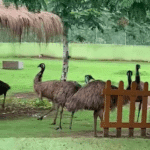These are closely related to Big cats and considered as a bridging link due to its large and smaller stature.
Classification
Kingdom – Animalia
Phylum – Chordata
Class – Mammalia
Order- Carnivore
Family – Felidae
Genus- Neofelis
Species- nebulosa
It has short legs and a long tail. The coat is brownish to yellowish and with irregular strips, patches and spots. These species of cats are classified as one family.these are found in nepal, bangladesh and assam.
These have large dexterous paws with footpads for taking grip over branches. Their ankle bones are specialized for climbing and also have long canine teeths.
They are found in dry woodlands, secondary forest, mangrove swamps.they are typically rainforest dwellers and nocturnal and arboreal in their habitats to avoid competition of food.their tails provide them balance on trees.As males are larger than females so there is always a chance of injury to females during mating. They live in solitary manners and even during mating they can kill their mate so mating at a younger age is considered to be a good choice.
The cubs of leopard are small , without teeth, can’t open their eyes and are not able to walk.After 6 months the young ones are totally weaned and with full colouration on their body. These cats are very secretive and difficult to understand their natural habitat. Due to different bone structure they growling, hissing. They have sub species namely brachyurus, macroscelides, n.nebulosa.
They are carnivores and they believe in normal hunting and feed on birds, squirrels,monkeys. Their chief prey are gibbons which stalk from ground.The life span is from 12-15 years.The leopards are highly at risk due to habitat destruction , illegal wildlife trade, and human leopard conflicts. WWF has set anti- anti-poaching units and has made strong laws against any illegal activity.
By- Pragya Joshi
Content Writer (Erakina By RTMN)
11/12/2021






